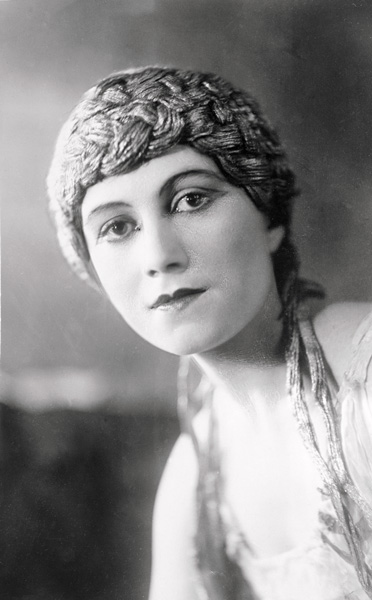From 1909 onward, Diaghilev ensured the troupe’s success by diversifying its repertoire and by introducing a policy of presenting classic ballets and premiering works in a Russian folk style in the same program.12 Accordingly, at the Théâtre de Monte-Carlo in April 1911, Olga Khokhlova began her career as an artiste chorégraphique13 in three technically diverse ballets. In Les Sylphides, as one of the corps de ballet, she executed a series of steps in the pure academic tradition. She was also a slave in the Polovtsian Dances and a temple servant in Cléopâtre, a dizzying creation of Fokine’s and one of the company’s major successes after 1909: with sets and costumes by Bakst, the dancers executed movements inspired by Egyptian art and similar to the contemporary improvisations of Isadora Duncan, expanding the body language of classical ballet. Olga appeared next in Rome, Paris, and London, then at the Paris Opéra in December, where she was the slave in Scheherazade (fig. 1), another exotic and sensual Fokine choreography of the Symphonic Suite by Nikolai Rimsky-Korsakov.14 After performances in Berlin, Dresden, Vienna, and Budapest, her repertoire began to expand in response to Diaghilev’s wish to promote the most deserving dancers of the corps de ballet. In April and May 1912 at the Théâtre de Monte-Carlo, Olga appeared in an adaptation of Le Lac des cygnes (Swan Lake) by Fokine of the version by Marius Petipa and Lev Ivanov staged at the Mariinsky in 1895. She also appeared in L’Oiseau de feu (The Firebird) and Petrushka, two national masterpieces that were the fruit of a close collaboration between Fokine, Igor Stravinsky, and the troupe’s three leading decorative designers, Alexander Golovin and Bakst for the first one, Benois for the latter. On 20 May, she danced the part of a serving girl in the premiere of Thamar at the Théâtre du Châtelet in Paris and her name finally appeared on the program of L’Après-midi d’un faune (The Afternoon of a Faun), the first choreographic creation by Nijinsky for the Ballets Russes set to the Prélude of the same title by Claude Debussy (fig. 2). With the set and the Greek tunics by Bakst, Olga was one of the six young nymphs dancing barefoot, their faces turned in profile and bodies facing the stage, in a succession of slow, stylized gestures that seemed to mime the bas-relief sculptures on an ancient frieze. On 29 May 1912, the evening of the premiere, the ballet’s hieratic stylization, drawn from the pagan wellsprings of the dance, left the audience disconcerted, and Nijinsky’s final gesture was deemed indecent and censured by the critics.
After touring Europe, including performances in Monte-Carlo, Diaghilev’s company opened the first season of Gabriel Astruc’s new Théâtre des Champs-Élysées,15 where on 29 May 1913 it presented Le Sacre du Printemps (The Rite of Spring), one of the most important works of the twentieth century. Stravinsky’s composition carried experimental rhythms and mixed tonalities to paroxysmal height in a violent orchestral score conducted by Pierre Monteux, while Nijinksy’s choreography broke with the academicism and the idea of grace traditionally associated with the art of ballet: instead of beginning with erect posture in “open” position, the dancers appeared onstage in a position rentrée, with toes turned inward and backs bent to the ground. The opening performance of this great tableau of “pictures from pagan Russia” with decor and costumes by Nicolas Roerich, in which Olga danced as one of the young maidens, created an immense scandal.
12. See Sally Banes, “Firebird and the Idea of Russianness,” ch. 6 of The Ballets Russes and Its World (Nancy Van Norman Baer, Lynn Garafola eds.), New Haven and London: Yale University Press, 1999; and David Vaughan, “Classicism and Neoclassicism,” ch. 8 (ibid.).
13. Olga’s occupation is thus described on her identity papers reproduced in Pierre Daix, Armand Israël, Pablo Picasso. Dossiers de la Préfecture de police. 1901-1940, Paris: Catalogues Raisonnés / Acatos, 2003, pp. 52, 55.
14. From 1915, Olga Khokhlova dances in Scheherazade as a Sultan Slave. For details of these tours, see Serge L. Grigoriev, The Diaghilev Ballet, 1909-1929, 1953, repr. London: Dance books, 2009 ; Richard Buckle, Diaghilev, London: Weidenfeld and Nicolson, 1979 ; Nesta MacDonald, Diaghilev Observed by Critics in England and the United States, 1911-1929, New York: Dance Horizons; London, Dance Books, 1975.
15. Located at 15 rue Montaigne in Paris, the theater was built by the firm of Perret & Frères and decorated by Antoine Bourdelle, Maurice Denis, and Édouard Vuillard.





 Summary
Summary